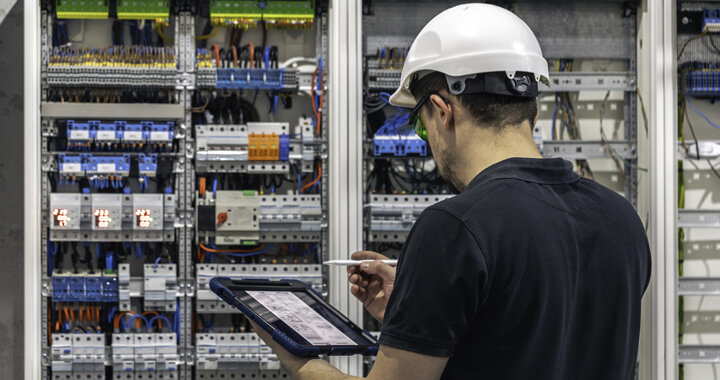The transition to intelligent buildings is gathering pace. Automated thermal comfort, intelligent lighting, enhanced security, fine-tuned energy management… the technical systems are multiplying and becoming ever more efficient. But with this sophistication comes a new complexity: how can such a wide range of equipment, often from different manufacturers and operating on heterogeneous protocols, be controlled in a unified way?
Faced with this fragmentation, the Facility Management plays a crucial role. It centralises the SCADA of all the technical equipment in a building – HVAC, heating, lighting, security, etc. – within a single interface. – through a single interface. And to guarantee smooth, efficient management of a building, this Facility Management must now be interoperable, scalable and adapted to new uses.
What is a building Facility Management in 2025?
Facility Management is a SCADA system used to monitor, control and analyse all the technical installations in a building from a single control station. It should be distinguished from BMS (Building Management System), which also includes automatic regulation and energy optimisation functions.
By 2025, Facility Management will be taking on a more strategic role. It will no longer be limited to collecting alarms or displaying temperature curves: it will become a unified business interface, capable of cross-referencing technical data, aggregating information from multiple protocols, and providing an overview of how the building is operating. This interface can take the form of dynamic synoptics, interactive plans or 3D views, enabling fluid navigation throughout the installation.
This development is part of an intelligent SCADA approach, where every piece of data collected can be analysed, correlated and transformed into concrete action: triggering preventive maintenance, adjusting a setting, sending an alert to the technical teams. To meet these challenges, a modern Facility Management must therefore be designed as a genuine nervous system for the building, capable of orchestrating equipment with multiple languages in real time.
The challenge of interoperability: one building, dozens of languages
An intelligent building is not a blank sheet of paper: it relies on a multitude of equipment, installed at different times, from different manufacturers and using different protocols. While this diversity allows a certain freedom of technological choice, it also entails a major risk: that of systems segregation.
Without interoperability, Facility Management becomes a collection of independent sub-systems, each with its own interface, its own rules, and often with no communication gateway. The result: fragmented SCADA, loss of critical information, a complex learning curve for teams, and reduced operational efficiency.
The challenge is clear: a modern Facility Management must be capable of bringing these disparate worlds together, standardising data and making it manageable through a single interface. This is precisely where the Panorama platform really comes into its own: by facilitating the integration of a wide range of heterogeneous equipment, from different protocols and generations. It enables the data collected to be centralised and standardised, so that it can be presented in a unified, clear and operational interface for effective management.
This native interoperability is a major advantage for operators. It enables existing investments to be preserved, while allowing the system to evolve at its own pace. It also ensures greater building resilience, by avoiding dependence on a single supplier or a fixed architecture.
Overview: building SCADA at the heart of a unified Facility Management
Given the increasing complexity of technical installations, Panorama, the SCADA platform developed by Codra, has become a central pillar of Facility Management. Designed to integrate heterogeneous environments, it enables all the technical equipment in a building (whether old or new, standardised or proprietary) to be monitored, controlled and analysed centrally in real time.
Panorama’s native interoperability means it can communicate with a wide range of industrial and home automation protocols, and interface with a variety of equipment (HVAC, lighting, security, BMS, lifts, access systems, etc.). All the data collected is displayed in the form of customised synoptics, interactive maps or contextual views, enabling fluid and intuitive navigation within the building.
In practical terms, Panorama allows you to:
- quickly locate a technical alarm and identify the equipment affected;
- monitor energy consumption by zone to adjust settings;
- control several buildings from a centralised station, even remotely ;
- correlate several technical events to automatically trigger action scenarios.
This comprehensive approach enables operations teams to manage buildings more efficiently, reduce the need for emergency interventions and improve their energy performance. It also paves the way for integration with complementary technologies, such as BIM Operation, GIS and connected objects, to take building intelligence even further.
This technological openness guarantees long-term investment and the ability of the system to evolve without jeopardising the existing system. Panorama is therefore part of a sustainable SCADA approach, capable of supporting the building’s digital transition over the long term.
An intelligent building is not just a juxtaposition of sophisticated systems. It relies on fluid, coherent and interoperable orchestration of all its equipment. This is precisely the role of Facility Management, when supported by a solution like Panorama, designed to centralise, contextualise and secure technical data.
By unifying languages, offering a clear, scalable business interface and opening the door to innovation, Panorama enables managers to regain control of their installations. SCADA then becomes a genuine technical decision-making centre, serving energy performance, user comfort and service continuity.






